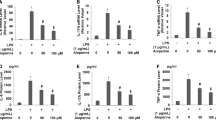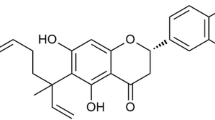Summary
Excessive activation of macrophages is implicated in various inflammatory injuries. Salidroside (Sal), one of the main bioactive components of Rhodiola Sachalinensis, has been reported to possess anti-inflammatory activities. This study aimed to examine the effect of Sal on the activation of macrophages and the possible mechanism. The lipopolysaccharide (LPS)-stimulated phrobol 12-myristate 13-acetate (PMA)-differentiated THP-1 macrophage models were established. The changes in the inflammatory profiles of THP-1-derived macrophages were determined. The results showed that Sal significantly decreased the expression of inducible nitric oxide synthase (iNOS), cyclooxygenase-2 (COX2), interleukin-1beta (IL-1β), interleukin-6 (IL-6) and tumor necrosis factor-α (TNF-α) at both mRNA and protein levels in THP-1-derived macrophages, and the effect was dose-depedent. Moreover, NF-κB activation was significantly suppressed and the phosphorylation of ERK, p38 and JNK was substantially down-regulated after Sal treatment. The findings suggested that Sal can suppress the activation of LPS-stimulated PMA-differetiated THP-1 cells, as evidenced by the decreased expression of iNOS, COX2, IL-1β, IL-6 and TNF-α, and the mechanism involves the inhibition of NF-κB activation and the phosphorylation of the MAPK signal pathway.
Similar content being viewed by others
References
Tabas I, Glass CK. Anti-inflammatory therapy in chronic disease: challenges and opportunities. Science, 2013, 339(6116):166–172
Lewis DH, Chan DL, Pinheiro D, et al. The immunopathology of sepsis: pathogen recognition, systemic inflammation, the compensatory anti-inflammatory response, and regulatory T cells. J Vet Intern Med, 2012,26(3):457–482
Choy E. Understanding the dynamics: pathways involved in the pathogenesis of rheumatoid arthritis. Rheumatology (Oxford). 2012,51(Suppl 5):v3–v11
Vucević D, Radak D, Radosavljević T, et al. Inflammatory process in atherogenesis: new facts about old flame. Arterioscler Thromb Vasc Biol, 2012,65(9-10):388–395
Hursting SD, Hursting MJ. Growth signals, inflammation, and vascular perturbations: mechanistic links between obesity, metabolic syndrome, and cancer. Arterioscler Thromb Vasc Biol, 2012,32(8):1766–1770
Olson N, van der Vliet A. Interactions between nitric oxide and hypoxia-inducible factor signaling pathways in inflammatory disease. Nitric Oxide, 2011,25(2):125–137
Sautebin L. Prostaglandins and nitric oxide as molecular targets for anti-inflammatory therapy. Fitoterapia, 2000, 71(Suppl 1):S48–S57
Sharma JN, Al-Omran A, Parvathy SS. Role of nitric oxide in inflammatory diseases. Inflammopharmacology, 2007,15(6):252–259
Martinez FO, Helming L, Gordon S. Alternative activation of macrophages: an immunologic functional perspective. Annu Rev Immunol, 2009,27:451–483
Aderem A. Role of Toll-like receptors in inflammatory response in macrophages. Crit Care Med, 2001,29(7 Suppl):S16–S18
Dobrovolskaia MA, Vogel SN. Toll receptors, CD14, and macrophage activation and deactivation by LPS. Microbes Infect, 2002,4(9):903–914
Guha M, Mackman N. LPS induction of gene expression in human monocytes. Cell Signal, 2001,13(2):85–94
Schmid D, Gruber M, Piskaty C, et al. Inhibition of NF-κB-dependent cytokine and inducible nitric oxide synthesis by the macrocyclic ellagitannin oenothein B in TLR-stimulated RAW 264.77 macrophages. J Nat Prod, 2012,75(5):870–875
Chen F, He SS, Qiu RY, et al. Influence of Silencing TRAF6 with shRNA on LPS/TLR4 Signaling in vitro. J Huazhong Univ Sci Technol [Med Sci], 2010,30(3):278–284
Guo N, Hu Z, Fan X, et al. Simultaneous determination of salidroside and its aglycone metabolite p-tyrosol in rat plasma by liquid chromatography-tandem mass spectrometry. Molecules, 2012,17(4):4733–4754
Guan S, Feng H, Song B, et al. Salidroside attenuates LPS-induced pro-inflammatory cytokine responses and improves survival in murine endotoxemia. Int Immunopharmacol, 2011,11(12):2194–2199
Li D, Fu Y, Zhang W, et al. Salidroside attenuates inflammatory responses by suppressing nuclear factor-κB and mitogen activated protein kinases activation in lipopolysaccharide-induced mastitis in mice. Inflamm Res, 2013,62(1):9–15
Guan S, Xiong Y, Song B, et al. Protective effects of salidroside from Rhodiola rosea on LPS-induced acute lung injury in mice. Immunopharmacol Immunotoxicol, 2012,34(4):667–672
Kucinskaite A, Briedis V, Savickas A. Experimental analysis of therapeutic properties of Rhodiola rosea L. and its possible application in medicine. Medicina (Kaunas) 2004,40:614–619
Mao GX, Wang Y, Qiu Q, et al. Salidroside protects human fibroblast cells from premature senescence induced by H(2)O(2) partly through modulating oxidative status. Mech Ageing Dev, 2010,131(11-12):723–731
Wu YL, Lian LH, Jiang YZ, et al. Hepatoprotective effects of salidroside on fulminant hepatic failure induced by D-galactosamine and lipopolysaccharide in mice. J Pharm Pharmacol, 2009,61(10):1375–1382
Li F, Tang H, Xiao F, et al. Protective effect of salidroside from Rhodiolae Radix on diabetes-induced oxidative stress in mice. Molecules, 2011,16(12):9912–9924
Daigneault M, Preston JA, Marriott HM, et al. The identification of markers of macrophage differentiation in PMA-stimulated THP-1 cells and monocyte-derived macrophages. PLoS One, 2010,5(1):e8668
He X, Shu J, Xu L, et al. Inhibitory effect of Astragalus polysaccharides on lipopolysaccharide-induced TNF-α and IL-1β production in THP-1 cells. Molecules, 2012,17(3):3155–3164
Dilshara MG, Jayasooriya RG, Lee S, et al. Water extract of processed Hydrangea macrophylla (Thunb.) Ser. leaf attenuates the expression of pro-inflammatory mediators by suppressing Akt-mediated NF-κB activation. Environ Toxicol Pharmacol, 2013,35(2):311–319
Connelly L, Palacios-Callender M, Ameixa C, et al. Biphasic regulation of NF-kappa B activity underlies the pro- and anti-inflammatory actions of nitric oxide. J Immunol, 2001,166(6):3873–3781
Cuccurullo C, Fazia ML, Mezzetti A, et al. COX-2 expression in atherosclerosis: the good, the bad or the ugly? Curr Med Chem, 2007,14(15):1595–1605
Locksley RM, Killeen N, Lenardo MJ. The TNF and TNF receptor superfamilies: integrating mammalian biology. Cell, 2001,104(4):487–501
Wan F, Lenardo MJ. The nuclear signaling of NF-kappaB: current knowledge, new insights, and future perspectives. Cell Res, 2010,20(1):24–33
López-Franco O, Suzuki Y, Sanjuán G, Blanco J, et al. Nuclear factor-kappa B inhibitors as potential novel anti-inflammatory agents for the treatment of immune glomerulonephritis. Am J Pathol, 2002,161(4):1497–1505
Wang S, Liu Z, Wang L, et al. NF-kappaB signaling pathway, inflammation and colorectal cancer. Cell Mol Immunol, 2009,6(5):327–334
Corbetta S, Vicentini L, Ferrero S, et al. Activity and function of the nuclear factor kappaB pathway in human parathyroid tumors. Endocr Relat Cancer, 2005,12(4):929–937
Lee AK, Sung SH, Kim YC, et al. Inhibition of lipopolysaccharide-inducible nitric oxide synthase, TNF-alpha and COX-2 expression by sauchinone effects on I-kappaB alpha phosphorylation, C/EBP and AP-1 activation. Br J Pharmacol, 2003,139(1):11–20
Marks-Konczalik J, Chu SC, Moss J. Cytokine-mediated transcriptional induction of the human inducible nitric oxide synthase gene requires both activator protein 1 and nuclear factor kappaB-binding sites. J Biol Chem, 1998, 273(35):22201–22208
Johnson GL, Lapadat R. Mitogen-activated protein kinase pathways mediated by ERK, JNK, and p38 protein kinases. Science, 2002,298(5600):1911–1912
Dai JN, Zong Y, Zhong LM, et al. Gastrodin inhibits expression of inducible NO synthase, cyclooxygenase-2 and proinflammatory cytokines in cultured LPS-stimulated microglia via MAPK pathways. PLoS One, 2011,6(7):e21891
Lee MS, Kwon MS, Choi JW, et al. Anti-inflammatory activities of an ethanol extract of Ecklonia stolonifera in lipopolysaccharide-stimulated RAW 264.7 murine macrophage cells. J Agric Food Chem, 2012,60(36):9120–9129
Cheng YW, Chang CY, Lin KL, et al. Shikonin derivatives inhibited LPS-induced NOS in RAW 264.7 cells via downregulation of MAPK/NF-kappaB signaling. J Ethnopharmacol, 2008,120(2):264–271
Xie C, Kang J, Ferguson ME, et al. Blueberries reduce pro-inflammatory cytokine TNF-alpha and IL-6 production in mouse macrophages by inhibiting NF-kappaB activation and the MAPK pathway. Mol Nutr Food Res, 2011,55(10),1587–1591
Chu X, Ci X, He J, et al. A novel anti-inflammatory role for ginkgolide B in asthma via inhibition of the ERK/MAPK signaling pathway. Molecules, 2011,16(9):7634–7648
Huang H, Fletcher A, Niu Y, et al. Characterization of lipopolysaccharide-stimulated cytokine expression in macrophages and monocytes. Inflamm Res, 2012,61(12):1329–1338
Fitzgerald ML, Moore KJ, Freeman MW, et al. Lipopolysaccharide induces scavenger receptor A expression in mouse macrophages: a divergent response relative to human THP-1 monocyte/macrophages. J Immunol, 2000, 164(5):2692–2700
Lee CS, Shin YJ, Won C, et al. Simvastatin acts as an inhibitor of interferon gamma-induced cycloxygenase-2 expression in human THP-1 cells, but not in murine RAW264.7 cells. Biocell, 2009,33(2):107–114
Author information
Authors and Affiliations
Corresponding author
Additional information
This project was supported by grants from the National Natural Science Foundation of China (Nos. 81100282, 81030007, 81171558, 81271808), Program for Changjiang Scholars and Innovative Research Team in University (No. PCSIRT1131), and China Postdoctoral Science Foundation (No. 2013M531700).
Rights and permissions
About this article
Cite this article
Wang, Hw., Wu, T., Qi, Jy. et al. Salidroside attenuates LPS-stimulated activation of THP-1 cell-derived macrophages through down-regulation of MAPK/NF-kB signaling pathways. J. Huazhong Univ. Sci. Technol. [Med. Sci.] 33, 463–469 (2013). https://doi.org/10.1007/s11596-013-1143-6
Received:
Revised:
Published:
Issue Date:
DOI: https://doi.org/10.1007/s11596-013-1143-6




